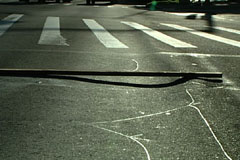 Kalia Road is one of the most heavily used roadways in the entire state of Hawaii, experiencing near constant bus, truck, and vehicle traffic. One section in particular, adjacent to the entrances of the Hilton Hawaiian Village Beach Resort and the Fort DeRussy Military Reservation, was in need of immediate repair. Under the current traffic conditions, the pavement in this area had experienced shoving (serious rutting) and had created serious liability concerns for the owners.
Kalia Road is one of the most heavily used roadways in the entire state of Hawaii, experiencing near constant bus, truck, and vehicle traffic. One section in particular, adjacent to the entrances of the Hilton Hawaiian Village Beach Resort and the Fort DeRussy Military Reservation, was in need of immediate repair. Under the current traffic conditions, the pavement in this area had experienced shoving (serious rutting) and had created serious liability concerns for the owners.
Severe pavement rutting on Kalia Avenue due to heavy bus, truck, and car traffic.
This pavement distress had occurred during a four to five year period, indicating serious base layer failures that an additional bituminous overlay would not address.
Instead, engineers chose to correct the base failure through full-depth reclamation (FDR) and then complete the roadway with a ultra-thin whitetopping (UTW) surfacing. Full-depth reclamation rebuilds failed flexible pavements by recycling the existing roadway. The old asphalt and base materials are pulverized, mixed with cement and water, and compacted to produce a strong, durable base. Ultra-thin whitetopping is a thin (typically 2 to 4 inches) conventional concrete layer placed over a prepared base. This combination of FDR and UTW layers was intended to bond together to create a monolithic structure capable of supporting the current and predicted traffic loadings.
The Kalia Road project included four lanes of traffic and an intersection crosswalk area covering more than 1,200 square yards. A reclaimer first pulverized the existing asphalt surfacing and underlying base materials to a depth of 13 inches. At this point, 4 inches of reclaimed material was removed from the project to accommodate the future 4-inch thick ultra-thin whitetopping layer. An application rate of eight percent portland cement by volume of reclaimed material (approximately 6 percent by dry weight) was spread over the area and then incorporated into the remaining nine inches of pulverized material through an additional pass with the reclaimer. The pulverized and blended materials were then brought to optimum moisture content, compacted with a 12-ton vibratory roller, and shaped to plan elevations.
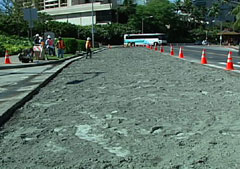
Dry cement uniformly spread on project after pulverization and removal of some material.
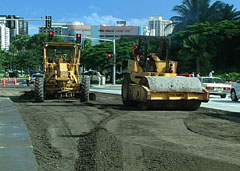
Compacting and shaping of the reclaimed roadway materials
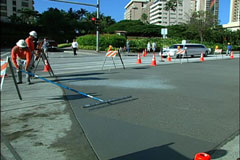 The reclaimed material was kept moist through the afternoon and evening by applications of a water truck. The installation of traffic loops took place directly on top of the reclaimed base material and the UTW surface layer was placed the following morning. A water-cement ratio between .35 and .38 was targeted for development of high early strengths and long-term durability of the product. Slump was kept between five and six inches with the driver of the ready mix truck making final adjustments of the slump with a high range water reducer. A crew placed and finished the concrete, and then changed the surface texture as required by the owners.
The reclaimed material was kept moist through the afternoon and evening by applications of a water truck. The installation of traffic loops took place directly on top of the reclaimed base material and the UTW surface layer was placed the following morning. A water-cement ratio between .35 and .38 was targeted for development of high early strengths and long-term durability of the product. Slump was kept between five and six inches with the driver of the ready mix truck making final adjustments of the slump with a high range water reducer. A crew placed and finished the concrete, and then changed the surface texture as required by the owners.
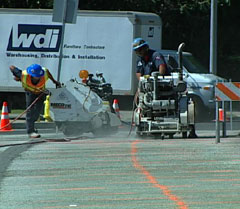 One of the final steps was the application of a concrete curing compound to provide the ultra-thin whitetopping additional protection from the weather and ensure proper strength development. Control joints were then sawn into the ultra-thin whitetopping in 3- feet-by-4 feet sections. Unconfined compressive strengths recorded for this project were 2,842 pounds per square inch (psi) in one day, 4,230 psi in two days, 7,105 psi in 14 days, and 8,500 psi in 28 days.
One of the final steps was the application of a concrete curing compound to provide the ultra-thin whitetopping additional protection from the weather and ensure proper strength development. Control joints were then sawn into the ultra-thin whitetopping in 3- feet-by-4 feet sections. Unconfined compressive strengths recorded for this project were 2,842 pounds per square inch (psi) in one day, 4,230 psi in two days, 7,105 psi in 14 days, and 8,500 psi in 28 days.
Placing control joints in the UTW layer with an early entry saw.
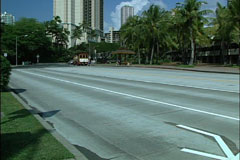
Traffic was allowed back on the completed sections by early the next morning –right on schedule! In addition to its superior strength and durability, this FDR and UTW approach proved to be a safer, more cost effective, and less disruptive rehabilitation method.
Completed Kalia Road FDR and UTW project